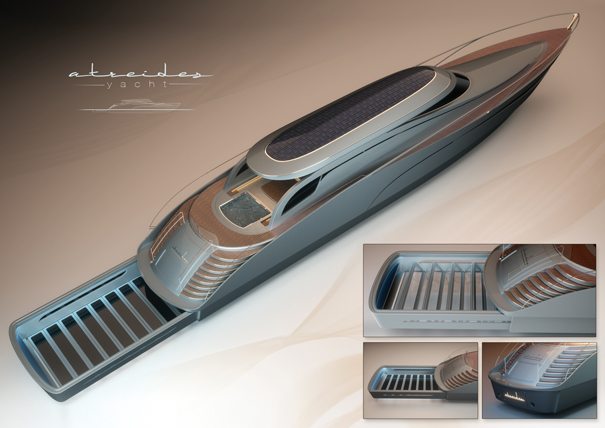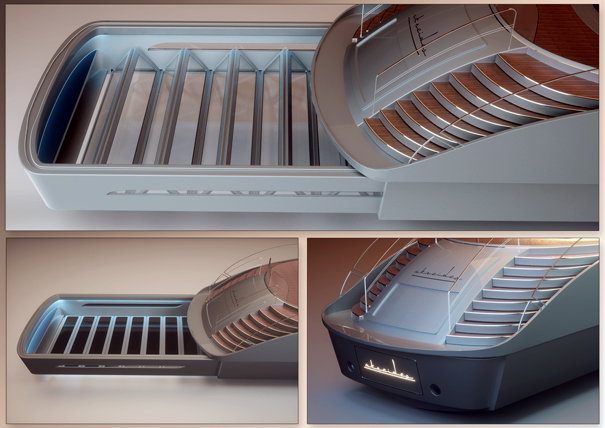The Future of Higher Education: Reshaping Universities through 3D Printing
Earlier this year, the building's DeLaMare Science and Engineering Library became one of the first academic libraries in the United States to provide 3D scanning and printing to all students and faculty, as well as the public. The move is part of a plan by director Tod Colegrove to transform the facility from a typical library that promotes knowledge through books to one that also encourages creative thought and discussion via hands-on technology. With 3D printers jumping from the realm of geek fantasy to something more accessible, Colegrove thought the devices would serve as the perfect vehicle for promoting education and pushing DeLaMare's evolution.
"If you look back at libraries over 2,000 years -- including the Library of Alexandria -- you'll see that they were involved in buying technology that many people cannot afford and making them more accessible," Colegrove said. "Along the way, it became all about having the biggest and best book collection so you ended up having identical libraries. We lost our way."
Paper or plastic?
For Colegrove, part of libraries losing their way involves the quiet, sanitized atmosphere that pervades many such facilities today. In the old days, libraries were largely about the conversation -- a fundamental part of learning and human nature, he said.
One section of DeLaMare Library's walls, for example, is covered in whiteboard paint, which makes it easier for students to write out their ideas or map out calculations in groups.
"The biggest mistake we made is when we let books crowd out the users and libraries became a quiet place where there's no talking and no food and drinks," Colegrove said. "We need to adjust from having conversations in users' heads to a collaborative environment."
"The biggest mistake we made is when we let books crowd out the users and libraries became a quiet place."
In order to take DeLaMare to the next level, Colegrove felt that it needed an anchor to draw in the diverse set of people needed to make creative collaboration possible. That's when he started thinking about 3D printers. Although the devices have been around since the '80s, 3D printers are still a relatively new concept to most people and just recently became more accessible to average consumers. The novelty of using layer after layer of melted plastic to "print" actual three-dimensional objects also gave 3D printers a "cool factor." Add the ability to turn people's ideas into something that's physically tangible and you have technology that could serve an educational purpose as well, Colegrove thought.
As great as 3D printers sounded, however, the library still faced one challenge: cost. Although it was possible to get a printer like the
MakerBot Replicator for around $2,000, Colegrove wanted a higher-end machine that could print faster at a high resolution while also being able to handle a heavy demand reliably. He decided to pick two devices -- the $20,000 Stratasys uPrint SE Plus professional-grade printer and a $4,000 3DTouch hobbyist machine. Throw in the cost of a 3D scanner and about a year's worth of plastic material and the library was looking at an expense between $30,000 and $40,000.
With the university system facing steep budget cuts after the Great Recession razed the state budget, Colegrove was apprehensive about pitching his plan to his superiors. After much thought, he decided to take the chance.
"When I first thought about getting funding from the school for the 3D printers, I was worried about the cost," Colegrove said. "But one of the people I talked to said, 'Oh, that's nothing, it's just the price of one microscope.' After that, I was like, 'OK, I don't feel so bad.'"
A matter of perspective
Thanks to a combination of university gift funds and grants, the library soon acquired its two 3D printers. The 3DTouch arrived first on April 27th and was printing its first job -- a rotor for an impeller pump prototype designed by a group of engineering students -- just minutes later. The rotor would take three days to finish.
"The students just broke the box open and started printing right away," said Lisa Kurt, DeLaMare's engineering and emerging technologies librarian. "They just looked so excited and you could feel this tremendous energy."
"It's really heartwarming to see just how backed up the machines are."
The library's Stratasys uPrint SE Plus arrived two months later on June 27th. The Stratasys, which prints four times faster than the 3DTouch and is jokingly described by Colegrove as their "Mercedes- Benz," has been running constantly since starting operation on July 3rd. Students have printed a range of devices that run the gamut from a bust of Master Yoda and
RepRap 3D printer parts to intricate models of molecules and an engine block. Several of the creations churned out by the devices are now on display next to the printers, along with a "Box of Disappointment" that contains discarded pieces that didn't quite turn out perfectly. For Colegrove, the strong demand for the printers validated his bet to bring the technology to the library.
"It's really heartwarming to see just how backed up the machines are," Colegrove said.
The waiting list got even longer in August, when the 3DTouch was taken offline due to a print head issue. The library also plans to replace the 3DTouch's build platform with a heated version after some projects printed from the device exhibited signs of warping.
Meanwhile, the library's "one-year supply" of 35 total PLA and ABS plastic spools is down to just a third of the original amount after only a couple of months. The supply issue should rectify itself once the university starts charging for the material -- 50 cents per cubic inch for 3DTouch jobs and $4.50 per cubic inch for the higher-resolution Stratasys. Kurt says strong demand will continue to be an issue now that students are back for the fall semester.
"Word has caught around campus and we were already busy even during the summer months," Kurt said. "But it's a good problem to have. I'd rather have people coming in to the library to use the printers than have an empty room."
A new dimension in learning
For many universities, 3D printers have become an indispensable asset for promoting learning and education. At
Columbia University's Graduate School of Architecture, Planning and Preservation (GSAPP), the devices are considered a regular tool in student's everyday lives, said Carlito Bayne, manager of the GSAPP's Output Shop. He says the school has dabbled with 3D printers since 2000, including one that used wax. Their printers get so much use that the school is purchasing another machine. Other departments such as the fine arts, medical and engineering schools have their own 3D printers.
"During presentations most students have models as well as renderings to show the design process," Bayne said. "It shows the students and professors what works structurally and what just looks good. This is something that a 2D render or drawing can't do because you only have one view."
"I think it's creating a Renaissance in manufacturing and the design world because even the average person can use it."
At the
Massachusetts Institute of Technology, students such as Steven Keating are using 3D printers in cutting edge ways that go beyond simple models. The mechanical engineering student describes 3D printers as a valuable research tool because they can help accelerate projects that would normally take time using conventional modeling methods. The technology also helps democratize processes that may be too technical for the average person when done the traditional way.
"3D printing allows you to prototype rapidly and iterate quickly so it really levels the playing field in terms of design," Keating said. "Anyone with a program like Sketchup can design something without needing access to a machine shop or knowing how to operate fabrication equipment. I think it's creating a Renaissance in manufacturing and the design world because even the average person can use it."
In Keating's case, he is currently part of a team that's studying new digital fabrication techniques, including large-scale 3D printing. Their ultimate goal? To be able to print entire buildings. Part of Keating's research is to come up with an alternative to the current layer-by-layer printing method used by machines such as the Makerbot, which is too slow for their purposes. One approach they are developing is to "print in place" -- which allows for printing to be done on site. Their concept also uses "mobile swarm printing" via robotic agents that extrude a fast curing material. The material acts as a concrete mold for structural walls and also doubles as a thermal insulation layer. In addition to lower costs and the ability to print custom shapes, the unique approach gives the team the speed that they desire. "We estimate that for a regular single-story residential house, we can print the entire exterior wall in under a day," Keating said. "So far, we've performed a lot of small scale tests successfully so we're hoping to work on a larger scale within the next year."
The next level

Although printing models of molecules, gears and even hobbyist projects in plastic are a good first step, one of the things that excites researchers about 3D printing involves its potential for using other materials. One example is using the technology for biological projects, including the creation of human tissue, said Ali Khademhosseini, a
Harvard Medical School associate professor who's also involved with the Harvard-MIT Division of Health Sciences and Technology. Khademhosseini and his fellow researchers are currently trying to engineer 3D structures that mimic cells and tissues that can be transplanted into humans. Unlike the more inanimate materials traditionally used, printing tissue material requires a different kind of medium that comes with its own set of unique challenges. "We typically deal with gels and pregel liquids where you have cells encapsulated inside," Khademhosseini said. "Once printed, you can cross link them and make a gel-like structure, so the material is different ... and very hydrated."
"The challenge now is making things like heart tissue, which is more vascularized and has all these blood vessels."
In the past, researchers tried to repurpose traditional printers for the job but ran into issues such as clogging. These days, they use printers from companies such as San Diego-based Organovo that specialize in printing biological material. The research could help speed up clinical trials by creating cells and tissues that can be used for testing drugs, Khademhosseini said. Larger trials, which can cost upward of a billion dollars, may also benefit by seeing reduced costs. So far, researchers working on biological printing have already created viable material for treating burned skin. More complicated tissues, however, will still take some time.
"The challenge now is making things like heart tissue, which is more vascularized and has all these blood vessels, or liver tissue, which has a metabolic function," Khademhosseini said. "There still are formidable challenges but we're making a lot of progress. Just being able to make tissues for drug discovery is already a big deal."
Meanwhile, printing speed remains a challenge for 3D printers overall, said Pedro Reis, an assistant professor of mechanical, civil and environmental engineering at MIT. Although 3D printing certainly has advantages as a prototyping tool, it still lags behind more traditional manufacturing methods when it comes to mass producing items, according to Reis. Nevertheless, its advantages as a tool for unlocking human creativity both individually and collaboratively can't be minimized.
"When you look at some of the crazy 3D objects that students come up with, you can't help but just go, 'Wow,'" Reis said. "It really empowers them and opens up their imagination. It opens up a completely new door for them to express their ideas."
More heads better than one
Sunlight seeps into the bustling DeLaMare atrium on a sunny Tuesday afternoon as visitors arrive to hang out around the 3D printers and observe the progress of their projects. In one corner, a teacher checks out one of the molecule models printed by a colleague and starts chatting with a computer science engineering student who's fiddling with the 3D scanner nearby. For Ben King, an associate professor of chemistry at the school, one of the challenges in making the connection between science and technology is the gulf in communication between people. Using 3D printers, he said, not only encourages people to flesh out their ideas and potentially create the next cool widget; it also makes it easier to communicate one's results to people outside one's field of expertise.
"For example, one of the very hard things about teaching chemistry is explaining that molecules have shape," King said. "This basically removes that obstacle ... so it will change how we teach chemistry and how we look at molecules on a daily basis. It's also just plain fun."
Guilherme Martins, a graduate student in the computer science and engineering program, agreed.
"In the field of robotics or mechanical engineering, the ability to create a moving part without any welding removes a lot of the barriers to prototyping," Martins said. "Using 3D printers also encourages you to learn something like a 3D modeling program so it pushes you to learn new skill sets."
On the other side of the room, one student can be seen interacting with another student at a nearby table while holding a sandwich in one hand and a drink in the other. Instead of telling the visitors to keep quiet and to dispose of their food, Colegrove joins in on the conversations.
"When I first came in (a couple of years ago), I talked to the dean and said, 'You know, scientists and engineers are known for a lot of things but they're not really known to be quiet people,'" Colegrove said. "We need to get that community back in the library."
"It allows us to break out of the box and cross-pollinate in ways that we normally can't. Cool stuff happens when you get people together."
The biggest benefit Colegrove has seen so far is the increase in visits from people of other backgrounds. As the library for one of the top mining schools in the country, DeLaMare has a strong history in the geosciences. With the addition of the 3D printers, the school's geological minds are now rubbing elbows with people from fields such as biology, computer science and even art.
Chris Bennett, a computer science engineering sophomore, said he especially enjoys the networking aspect of his visits to the 3D printing area. He briefly chatted with civil engineering senior Alicia Veach, who is planning to use the 3D printers to create miniature prototypes of the concrete canoes she and her team use in racing competitions around the country.
"You get your average engineering types but it's also nice to see the biologists and the artists coming in here," Bennett said. "It allows us to break out of the box and cross-pollinate in ways that we normally can't. It's basically tied to the Makerspace ethos -- cool stuff happens when you get people together."
This diverse meeting of the minds is exactly what Colegrove hopes to continue seeing as more folks become aware of the 3D printers. Colegrove alluded to the Gartner Hype Cycle, which explains the various phases that a technology goes through during adoption. The cycle starts with the creation of the technology followed by inflated expectations, disillusionment, enlightenment and the final phase of acceptance. Colegrove believes that 3D printers have passed the "disillusionment" phase that comes when a new technology fails to match the hype of inflated expectations. Instead, 3D printers are now starting to work their way up the "slope of enlightenment" stage, where most progress is achieved. How fast that translates to printing organs and Star Trek-style replicators, however, depends on how many people start playing with the technology now, he said. The key is collaboration, which speeds up the learning process, he added.
"The old model -- where you have individual silos and people went into their individual towers -- I mean, what good is that?" Colegrove said. "Now you have engineers talking with artists and creating new forms of knowledge. Instead of the old teaching model where you have the sage on the stage, the new model is about learning from one another to create a spark that can be fanned into a flame. You end up connecting all these dots."
Clarification: The University of Michigan 3D Lab also provides limited 3D printing services to the public on a case-by-case basis, provided there is space in the printing queue after students and faculty.

































